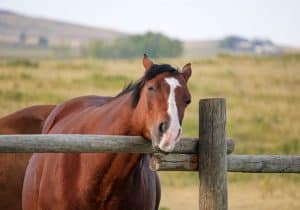Dealing with Burns on Horses
- Topics: Article, First Aid, Other Skin Problems
The night of May 31, 2011, a barn fire at Phillip Dutton’s True Prospect Farm in Pennsylvania took six horses’ lives. Five others were lucky enough to escape, but many of their burns were extensive and their recoveries slow. One of those survivors was Caitlin Silliman’s top-level event horse Catch a Star, who sustained superficial burns over 80% of her body. She lost significant skin on her left shoulder and along her neck, and her wounds were a combination of first-, second-, and third-degree burns. Her treatment included weeks of pain medications and antibiotics, diligent wound care and cleaning, and hyperbaric oxygen therapy sessions.
Nearly a year later, in March 2012, Silliman and Catch a Star were back in the show ring, competing at Pine Top Farm’s Spring Horse Trials in Georgia, with the help of a fitness-training program and a custom-made sheepskin saddle pad to prevent irritation over her permanently hairless spine area.
Tragic events like the True Prospect Farm barn fire are, fortunately, quite rare. But when they do happen, or when wildfire strikes, burns are injuries to be taken very seriously, as they can be deceptively deep. "Over the course of several days the wound might become larger and deeper than it appeared initially," explains Laura Riggs, DVM, PhD, Dipl. ACVS, assistant professor of Veterinary Surgery in Louisiana State University’s Department of Veterinary Clinical Sciences. For this reason and others, a veterinarian should promptly evaluate any horse that has survived a fire or sustained a burn injury.
Just as in humans, burns are categorized by degree. First- and second-degree burns leave the deeper layers of skin intact. These wounds generally heal well without grafting–a process in which the veterinarian removes healthy skin from one part of the body and transfers it to the wound bed to enhance healing. Third-degree burns (in which the skin is completely gone) and fourth-degree burns (involving damage to tissues beneath the skin, such as muscle, tendons, and bone) are life-threatening if the affected area is extensive. Many serious cases are a combination of second-, third-, and sometimes fourth-degree burns
Create a free account with TheHorse.com to view this content.
TheHorse.com is home to thousands of free articles about horse health care. In order to access some of our exclusive free content, you must be signed into TheHorse.com.
Start your free account today!
Already have an account?
and continue reading.
Written by:
Heather Smith Thomas
Related Articles
Stay on top of the most recent Horse Health news with















